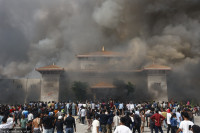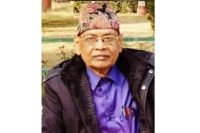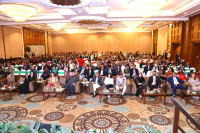Valley
Singha Durbar runs on solar power
The country’s administrative hub Singha Durbar started receiving power from the China-funded Solar Photovoltaic Project which kicked into operation on Tuesday.
Sanjeev Giri
The country’s administrative hub Singha Durbar started receiving power from the China-funded Solar Photovoltaic Project which kicked into operation on Tuesday.
Prime Minister KP Sharma Oli and Chinese Ambassador to Nepal Yu Hong jointly inaugurated the project amid a programme in Singha Durbar.
Joint Secretary at the Energy Ministry Dinesh Kumar Ghimire and Economic and Commercial Counsellor at the Chinese Embassy in Kathmandu Peng Wei exchanged the project handover documents during the function.
Works on the 1.3MW Solar Photovoltaic Project, which includes installation of rooftop photovoltaic devices on the existing buildings and the newly built parking lots in the country’s administrative hub, had begun in November 2016. According to the government officials, the project cost is estimated at around $5.97 million.
Solar panels have been installed on as many as 21 buildings in Singha Durbar, including the Prime Minister’s Office, the Ministry of Finance and the Ministry of Energy. “Surplus energy generated by the solar plant can be evacuated to the national grid,” said Ghimire, adding that the solar power will significantly reduce energy bills of several government offices.
Addressing the inaugural ceremony, PM Oli said the solar energy project would transcend beyond Singha Durbar to other government offices. “We have abundant water resource. But transmitting energy generated through water resource is costly,” Oli said. “If we install solar or wind power, especially in remote areas, it will be cheaper. It will also reduced our dependence on big projects and costly transmission lines.”
The PM added that the signing of the Belt and Road (BRI) Initiative by the Nepal government has opened a new avenue for cooperation with China in multiple areas. Nepal had signed BRI initiative in May, 2017.
Speaking on the occasion, Chinese Ambassador Yu said the project would become a model for Nepal to expand its energy supply channels, strengthen energy security and realise green development.
According to her, the Chinese government had recently donated 34,000 sets of household photovoltaic equipment with a total generation capacity of 750kW. “The Chinese government has been engaged in efforts to help Nepal realise electricity development. The efforts will continue in the future,” said Yu, underlining long-term cooperation between the two countries in the area of electricity and energy.
“We have agreed to establish dialogue mechanism between energy sectors for a better long-term planning. The two sides have reached consensus on establishing energy cooperation mechanism between competent authorities of both sides,” she said.
Expressing belief that cooperation under the BRI framework will bring new opportunities to the development of Nepal, Ambassador Yu assured China’s continued support for the socio-economic development of Nepal.
Previously, a study conducted by Asia Pacific Exchange and Cooperation Foundation (APEC) had suggested that Singh Durbar would require 3.5MW energy. Based on the study, the government initiated installation of solar panels with the generation capacity of 5MW in 2013.
The feasibility study began a year later. The project, however, had to be dropped because of the 2015 Gorkha Earthquake after several buildings inside Singha Durbar were severely damaged in the disaster.




 7.12°C Kathmandu
7.12°C Kathmandu










